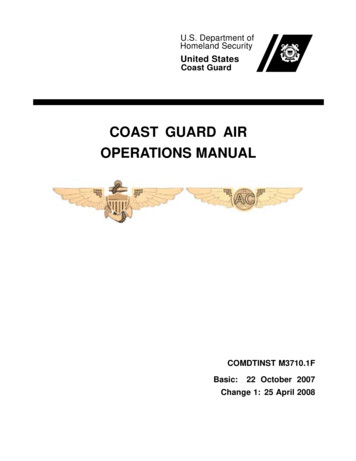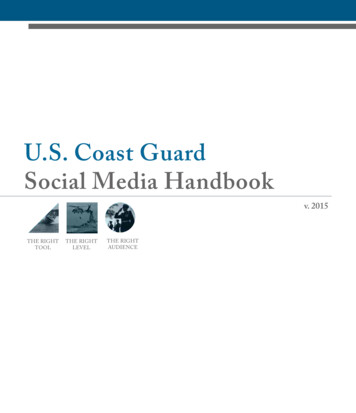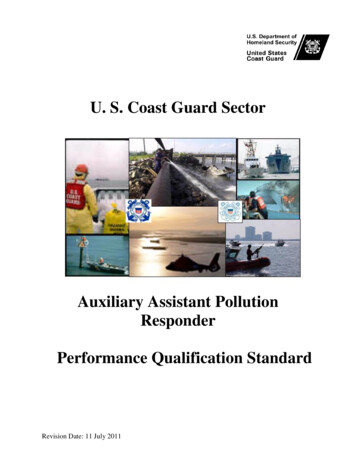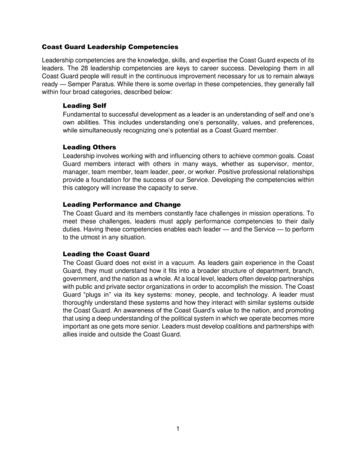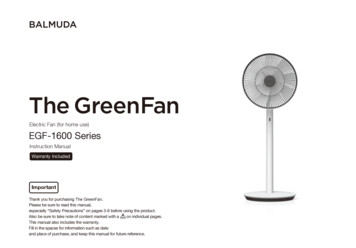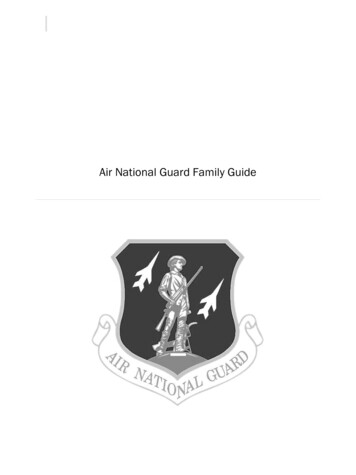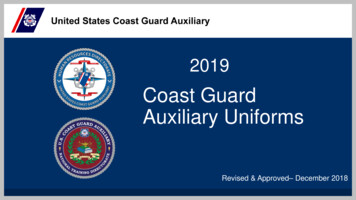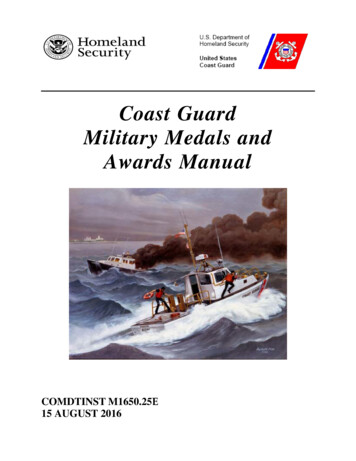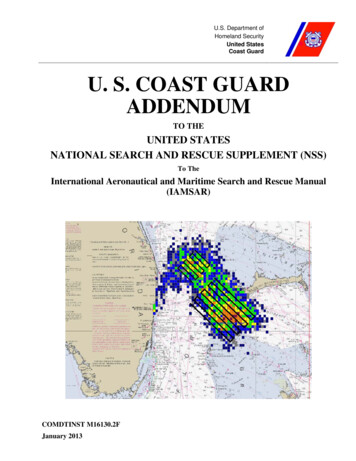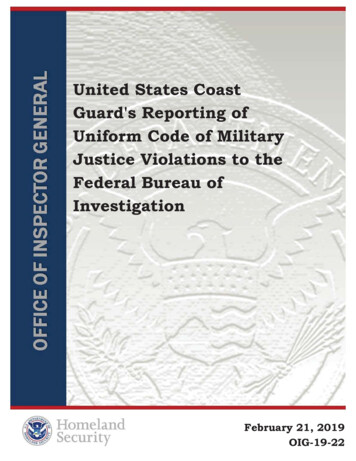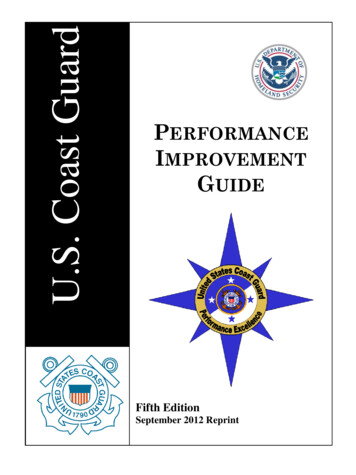
Transcription
U.S. Coast GuardPERFORMANCEIMPROVEMENTGUIDEFifth EditionSeptember 2012 Reprint
Editors:SCPO Robert R. BuxmanChristen M. WehrenbergProject Coordinator:SCPO Robert R. BuxmanContributors:AIM ConsultingCWO Michael J. BrzezickiSCPO Robert R. BuxmanCPO John M. CallaghanCharles D. CoiroFrederick L. HooghouseLT Jacqueline M. LeverichLori J. MaselliCDR Joseph M. RePaul E. RedmondJason M. Siniscalchi, Ph.DLCDR Richter L. TiptonFrank S. WoodJeff L. WrightChristen M. WehrenbergStephen B. Wehrenberg, Ph.DIf this guide is used as a reference in preparing a research paper or otherpublication, we suggest acknowledgement citation in the references. Here is asuggested bibliography entry in APA or ―author (date)‖ style:U.S. Coast Guard Leadership Development Center (2006). Performanceimprovement guide, 5th edition. Boston, MA: U.S. Government PrintingOffice.2
Preface to Fifth EditionThe Performance Improvement Guide (PIG) is published by theUS Coast Guard Leadership Development Center, in collaboration withthe Office of Performance Management (CG-0954).The Coast Guard strives to be the best-led and best-managedorganization in government. That's a never-ending challenge for allCoast Guard people. This guide is an aid to help you respond to thechallenge; its contents were selected to involve employees, enhanceteam effectiveness, ease problem-solving, facilitate better meetingmanagement, improve processes, increase customer satisfaction, andimprove overall performance to produce superior mission results.The PIG is an idea source of tools, processes, and models.Organizational Performance Consultants (OPCs) and the latestCommandant‘s Performance Excellence Criteria (CPEC) Guidebookare also valuable leadership and management resources.The Leadership Development Center appreciates the manyimprovement suggestions made by users of previous editions. Thoughthe PIG format remains largely the same, its contents and organizationhave changed. Changes to this edition include: A reorganized and expanded tool section, including basic projectmanagement tools A section on senior leadership, including strategic planning Updates to examples Updates to wording choice and explanations to reflect the CoastGuard‘s evolution in its continuous improvement effortsWe hope you find this a useful, informative resource.The Leadership Development Center Staffand the Performance Excellence Program3
CONTENTSU.S. COAST GUARD LEADERSHIP COMPETENCIES . 7LEADERSHIP RESPONSIBILITIES . 9SENIOR LEADERSHIP . 10Effective Management . 11Strategic Planning . 13Does every Unit Need its Own Strategic Plan? . 14U.S. Coast Guard Core Values . 20SWOT Analysis . 24Goal Writing Primer . 25The Balanced Strategic Plan . 28TEAM LEADERSHIP . 31Organizational Interface . 33Team Building . 35Project Management . 36FACILITATIVE LEADERSHIP . 39Facilitator Behaviors . 41Facilitator Checklist . 43Facilitator Pitfalls. 44The Facilitative Leader . 45MEETING MANAGEMENT . 46Effective Meetings . 46Planning a Meeting . 47Agenda Checklist . 47Team Member Roles. 48Ground Rules . 49Parking Lot . 50Meeting Evaluation . 52GROUP LEADERSHIP . 55Stages of Group Development . 56Managing Conflict . 57ORGANIZATIONAL PERFORMANCE . 58Systems Thinking . 59The Voice of the Customer . 684
Work as a Process . 70Performance Elements . 71Performance Measures. 73Data Collection, Analysis, and Display . 75Activity Based Costing (ABC) . 87The Unified Performance Logic Model (UPLM) . 89What to Work On. 91Process Improvement and Problem-Solving . 92The CG Organizational Assessment Survey (CG-OAS) . 96Coast Guard Business Intelligence (CGBI) . 98The Commandant‘s Innovation Council . 100TOOLS . 103Action Planning . 104Affinity Diagram . 106Brainstorming . 110Charter . 113Cause-and-Effect Diagram . 116Check Sheet . 118Consensus Cards . 120Contingency Diagram . 122Control Charts . 124Customer Alignment Questions . 127Customer Requirements Matrix . 128Decision Matrix . 129Flowchart . 131Force Field Analysis . 134Gantt Chart. 135Kano Model . 139Multi-Voting . 140Nominal Group Technique . 142Pareto Chart . 144Project Requirements Table . 146Project Responsibility Matrix . 147Run Chart . 1485
Scatter Diagram . 153SIPOC . 154Stakeholder Analysis . 156SWOT Analysis . 157Why Technique . 159Work Breakdown Structure (WBS) . 160GLOSSARY . 162REFERENCES . 165ADDITIONAL RESOURCES . 166TABLE OF TOOL USAGE . 168TABLE OF TOOL USAGE (DMAIC) . 168QUICK TOOLS REFERENCE GUIDE . 1706
U.S. COAST GUARD LEADERSHIP COMPETENCIESThe Coast Guard‘s definition of leadership is:―You influencing others to achieve a goal‖In this guide you will find ideas and resources to help youpositively influence others to achieve unit goals. Whether you‘rea team leader, team member, or facilitator, you have the potentialto lead and influence change.The Coast Guard uses 28 leadership competencies consistent withour missions, work force, and core values of Honor, Respect, andDevotion to Duty. These competencies fall into four categories: LEADING SELFo Accountability and Responsibilityo Followershipo Self Awareness and Learningo Aligning Valueso Health and Well-Beingo Personal Conducto Technical Proficiency LEADING OTHERSo Effective Communicationso Influencing Otherso Respect for Others and Diversity Managemento Team Buildingo Taking Care of Peopleo Mentoring7
LEADING PERFORMANCE AND CHANGEo Customer Focuso Management and Process Improvemento Decision Making and Problem Solvingo Conflict Managemento Creativity and Innovationo Vision Development and Implementation LEADING THE COAST GUARDo Stewardshipo Technology Managemento Financial Managemento Human Resource Managemento Partneringo External Awarenesso Entrepreneurshipo Political Savvyo Strategic ThinkingThe discussions, strategies, models, and tools in this guidestrongly support the development of most of these competencies.For more information on the Coast Guard‘s LeadershipCompetencies, see the Coast Guard Leadership DevelopmentProgram, COMDTINST 5351.1 (series).8
LEADERSHIP RESPONSIBILITIESSenior leaders, team leaders, and facilitators play key and supportroles in the managing and improving organizational performance.These roles include identifying important opportunities; aligningwith stakeholders; selecting the appropriate tools; planning work;training team members; cultivating teamwork;, implementingsolutions; and leading long-term change.The following matrix outlines some key and support roles:Team Role MatrixRoleSLTLFACManages organization Conducts planning Interfaces with organization Team Selects teamBuilds team Manages project Coordinates pre- and post-meeting logistics Encourages participation Contributes ideas Protects individuals and their ideas from attack Focuses on process Focuses energy of group on common task Remains neutral Helps find win/win solutions Key Role Support RoleSL Senior LeadersTL Team LeaderFAC FacilitatorThe senior leader, team leader, and facilitator roles,responsibilities, and checklists presented in this guide provide abrief overview. For more in-depth discussion, please refer to theadditional references section.9
SENIOR LEADERSHIPSenior leaders—whether at the organizational, unit, or workgroup level—are responsible for effective management.Management should be part of a regular routine, not a separateevent. Leading-edge organizations use performancemeasurement and management systems to gain insight into, andmake judgments about, the effectiveness and efficiency of theirprograms, processes, and people. Best-in-class organizationsdetermine and use indicators to measure progress toward meetingstrategic goals and objectives, gather and analyze performancedata, and use the results to both drive improvements andsuccessfully translate strategy into action.10
Effective ManagementThe Commandant‘s Performance Excellence Criteria (CPEC)provides a systematic way to improve management practicesacross the organization. The criteria are slightly modified fromthe Malcolm Baldrige National Performance Excellence Criteria,which are based on core principles and practices of the highestperforming organizations in the world. The Commandant‘sPerformance Challenge (CPC) Criteria are a subset of the CPECtailored specifically for new users.Organizational Profile:Environment, Relationships, and ChallengesCategory 5WorkforceFocusCategory 2StrategicPlanningCategory 1Category 7LeadershipResultsCategory 6ProcessManagementCategory 3Customer andMarket FocusCategory 4Measurement, Analysis, and Knowledge ManagementFigure 1. CPEC Framework: A Systems Perspective11
Actively using the criteria fosters systems thinking with a focuson factors such as missions, customers, innovation, people,measurement, leadership, processes, readiness, and stewardship.The way each leader manages assigned responsibilities hasimplications for the entire Coast Guard and the public we serve.In other words, management matters—excellent managementpractices equate to performance results. The best way leaderscan learn how the CPEC can help them accomplish commandgoals is to use the system.The criteria are built upon eleven core principles and concepts.These principles and concepts are the foundation for integratingkey performance requirements within a results-orientedframework. These core principles and concepts are: Visionary Leadership Customer-Driven Excellence Organizational and Personal Learning Valuing Employees and Partners Agility Focus on the Future Managing for Innovation Management by Fact Public Responsibility and Citizenship Focus on Results and Creating Value Systems PerspectiveFor more CPEC information, see the Commandant‘s PerformanceExcellence Criteria Guidebook, COMDTPUB P5224.2 (series).12
Strategic PlanningStrategic planning is the process by which leaders clarify theirorganization‘s mission, develop a vision, articulate the values,and establish long-, medium-, and short-term goals and strategies.The Strategic Planning Process presented in this guide is basedon the Hierarchy of Strategic Intent shown below. At the top ofthe hierarchy is the organization‘s Mission and Vision, both ofwhich should be long-lasting and motivating. At the base of thehierarchy are the shorter-term strategies and tactics that unitmembers will use to achieve the Vision.Hierarchy of Strategic strict)Tactical(Sector/Unit/Team)Use the Hierarchy to answer “Why my organization does X” bylooking up one level, e.g., “this set of tactical plans exist toachieve that Outcome.” Answer “How” the organization willaccomplish X by looking down one level, e.g., “our Strategies arehow we will attain our Critical Success Factors.”13
Does every Unit Need its Own Strategic Plan?Thetraditional viewof planning might dictatethat leaders at field unitsStrategic– Operational- Tacticaland even individual HQ program offices leave Strategic Planning to thesenior-most, agency-level leaders, as depicted ationalSector/UnitTacticalHowever, in reality, every USCG command/staff has strategic value. Toensureis ready to perform its ationalable to sustainand improve performance, and to anticipate and prepare for future needs,planning at all levels—Strategic, Operational, Tactical—is necessary.OperationalThe itOperationalTacticalRegionalSector/UnitThere are, however, differences in the planning scope and horizons at thenational, regional, and unit levels—perhaps 18-24 months for cutters, 5years for Sectors, 5-8 years for Areas, and 20 years for the Coast Guard.Strategic Planning process steps are listed below:Step Develop Guiding Documents. This includes developing1.0 Mission, Vision, and Values statements; if these alreadyexist, review them to prepare for strategic planning.Step Define the Strategy. This step is the heart of strategy2.0 development; it establishes Outcomes, Critical SuccessFactors, and outlines the Goals to accomplish both.Step Develop Action Plan and Execute. This includes developing3.0 action plans, allocating resources, and deploying the plan.Avoid an ―Execution Gap,‖ by conducting Action Planningin a disciplined manner and Execute Action Plans withaccountability.14
SITUATION ANALYSIS AND STRATEGIC ALIGNMENTPrior to strategic planning, leaders should study all the factorsthat may affect the organization during its target time-frame.Leaders should align the strategic plan with efforts up and downthe chain of command in such a way that it maintains a ―unity ofeffort‖ or common strategic intent. This analysis focuses on thefollowing. Planning Assumptions: resource constraints, strategicchallenges, organization sustainability issues, and emergencybusiness continuity Environmental Factors: Coast Guard strategic, operational,and tactical plans; and financial, societal, ethical, regulatory,and technological risks Future Focus: Major shifts in technology, missions, or theregulatory and competitive environments (particularly thosederived from up-line plans) Performance Metrics: such as mission/operationalperformance status and other key effectiveness measures Assessments: Organizational Assessment Survey (OAS);Commandant‘s Performance Challenge (CPC); unit climatesurveys; compliance inspection and audit findings; strategiccapability; and organizational strengths, weaknesses,opportunities, and threats15
Process StepsDEVELOP GUIDING DOCUMENTSOnce the leaders are ready to engage in the planning process,they should revisit or establish organizational GuidingDocuments, such as, Mission, Vision, and Values Statements.Since these Statements are long-lasting, they may require onlyslight adjustments to respond to changes in the operational orcompetitive environments. Reviewing them reorients theplanning team toward this enhanced future state. If suchdocuments do not exist, they must be developed before any otherplanning can occur. The essential steps in this process are:1.1Define theMission1.21.3Develop theVisionReview theValuesSTEP 1: Develop Guiding DocumentsDEFINE THE MISSIONA Mission refers to why an organization exists – its reason forbeing or purpose. Generally, for most military organizations, themission is clear and unambiguous. Well-articulated MissionStatements are those that clarify: For Members – What to expect and how they fit in;For Customers – What the products and services are;For Leaders – How to direct decision-making.16
A Mission Statement must: Be clear and understandable;Be brief enough for people to keep it in mind;Be reflective of the organization‘s distinctive competency;Be broad enough to allow implementation flexibility;Be narrow enough to maintain a sense of focus;Be a template by which members can make decisions;Reflect organization values, beliefs, and philosophy.DEVELOP THE MISSION STATEMENTTo develop a Mission Statement, leaders may facilitate thefollowing process with a team specifically selected for thispurpose.1. Individually, develop a mission statement based upon thecriteria listed here.2. As a group, share individual Mission Statements.3. Identify common themes and must haves.4. If useful, choose and modify an individual statement.5. Devote 5-10 minutes to refine the chosen statement.6. Check the refined statement against the criteria.7. If necessary, select a sub-team to finalize the statementoffline.DEVELOP THE VISIONVision refers to the category of intentions that are broad, allinclusive, and forward thinking. A Vision should: Provide aspirations for the future;Provide a mental image of some desired future state;Appeal to everyone‘s emotions and aspirations.17
BRAINSTORM INDIVIDUAL AND COLLECTIVE LEGACYStart by defining the organization for which the Vision is beingdeveloped. A Vision can be developed for a subgroup of a largerorganization, which has a separate, broader, more inclusiveVision. Subgroup Visions must be aligned with and mutuallysupportive of the larger organizational Vision. Ask the group toquietly and honestly list their own responses to the five questionsbelow. Tell participants they will be asked to share their answersto Questions 4 and 5 with the group.The Five Vision Questions1.2.3.4.5.What do you like about being a part of this organization?What do you like about the organization‘s mission?When it‘s at its best, what do you like about the organization?What legacy would you like to leave behind?What legacy should we collectively leave behind?REPORT INDIVIDUAL RESPONSES TO THE GROUPOnce everyone has listed their responses, go around the room andask each participant share his/her responses to Questions 4 and 5.The following ground rules apply. Speak from the heart Listen carefully Seek first to understand (clarifying questions only) Do not evaluate responsesIDENTIFY COMMON VISION THEMESAs a group, identify the common themes in the individualresponses to the questions. Has a Vision or the elements of aVision emerged? What‘s missing? Facilitate discussion until allkey elements have been fully developed and are clear to all.18
FINALIZE VISION STATEMENT OFFLINEIf necessary, select a smaller team to work offline to finalize theVision Statement. The team will use the responses and commonthemes as input to develop several Vision Statements for thegroup‘s approval. The simple act of developing these conceptswithin the group will provide enough direction to continuedeveloping the strategic plan.Trick of the Trade: Never wordsmith in a group! You’lldestroy momentum.Why Does a Unit Need Its Own Vision?Unit leaders often resist developing a Vision Statement. Manyfeel that their command‘s Vision should match theCommandant‘s Vision or the District Commander‘s Vision.They are correct to the extent that a unit‘s Vision must be alignedwith and supportive of those higher in the chain of command;however, many up-line Visions are too broad or all encompassingto be relevant to the members of a given unit. More importantly,each unit has a specific if not unique role in successful missionexecution and mission support. Leaders are responsible forarticulating that role and setting a Vision to drive improvementand higher levels of performance.A unit Vision should span a couple of COs tours or about fiveyears. A five-year Vision is often a reach for a field unit and isgenerally long enough to hold a crew‘s focus. It is also areasonable time frame given the ever-changing nature of theCoast Guard‘s operating environment and initiatives responsiveto a given Commandant‘s Intent.19
REVIEW THE VALUESValues are the essence of the organization. They describe whowe are and how we accomplish our work. Values affect: Decision-making; Risk taking; Goal setting; Problem solving; Prioritization.Core Values form the foundation on which we perform work andconduct ourselves. The values underlie how we interact with oneanother and the strategies we use to fulfill our mission. Corevalues are essential and enduring and cannot be compromised.Any strategy session should review the Coast Guard‘s CoreValues, listed below. The organization‘s Mission and Vision andall aspects of the Strategic Intent should be aligned with thesevalues. Because the Coast Guard Core Values are so pervasive, itis not necessary for units to develop their own; rather, assesshow/if the unit behaves consistent with and reinforces the values.U.S. Coast Guard Core ValuesHONOR. Integrity is our standard. We demonstrateuncompromising ethical conduct and moral behavior in all of ourpersonal actions. We are loyal and accountable to the public trust.RESPECT. We value our diverse workforce. We treat one anotherwith fairness, dignity, and compassion. We encourage individualopportunity and growth. We encourage creativity throughempowerment. We work as a team.DEVOTION TO DUTY. We are professionals, military and civilian,who seek responsibility, accept accountability, and are committed tothe successful achievement of our organizational goals. We exist toserve. We serve with pride.20
DEFINE THE STRATEGYDefining the Strategy is inherently a leadership responsibility.While Action Planning can be jointly accomplished byorganizational leaders and front-line teams, Coast Guard leaderscannot delegate strategy development.Developing strategy encompasses defining Outcomes from theStakeholders‘ perspective, identifying Critical Success Factors,and developing Goals for an 18- to 36-month time horizon.These Strategic Plan elements lay the groundwork for allstrategic activities within the command. The following outlinesessential steps in this process.2.12.2DefineOutcomes2.3Identify CriticalSuccess FactorsDevelop LongRange GoalsStep 2: Define the StrategyDEFINE OUTCOMESOutcomes are the organizational or public benefit(s) that the unitseeks to achieve or influence: Outcomes identify the impact the organization has as opposedto the activities in which it engages.Outcomes should be derived from Stakeholder perspectives,expressed as expected results from the organization.Outcomes should encompass multiple stakeholderperspectives to ensure they are ―balanced.‖Outcomes are not always under the full control of theorganization; many factors can influence outcomes. However, ifoutcomes are well defined and continually focused upon, theycan be attained more often than not!21
IDENTIFY STAKEHOLDERS1. Begin by asking:o Who has an interest in what the organization provides?o Who cares whether the organization succeeds?2. Participants can answer these questions on sticky notes(putting one stakeholder or group name on each). Whenfinished, they can randomly place the notes on butcher-blockpaper or a whiteboard.3. The participants then silently ―affinitize‖ the stakeholders byclustering similar groups into similar or related categories.Attempt to create four to eight categories and name them.4. Display these relationships in a diagram or chart.DEFINE STAKEHOLDER EXPECTATIONS1. Break the participants into groups; assign one the previouslydefined primary stakeholder groups to each breakout group.2. Ask each group to envision themselves riding a crowdedescalator on which two members of their assigned stakeholdergroup are on the stairs ahead of them. The stakeholders donot realize you are there and they are discussing theirexperience with your organization as you‘ve defined it in itsenhanced future state (Vision).3. Ask the group: What do you want to hear them say?4. Each group then reports out the top two or three stakeholderquotes that most represent a future desired outcome. Recordkey items or common themes that cut across groups.DEVELOP OUTCOMES1. Identify five to seven common outcome themes. Assignbreakout groups to develop them into Outcomes Statements.Outcome Statements should be measurable and directlyreflect the Vision.22
2. Ask each group to report their outcomes. Take comments,but do not allow the group to wordsmith.3. Assign an individual or small team to finalize the OutcomeStatements offline.IDENTIFY CRITICAL SUCCESS FACTORS (CSFS)CSFs are what the organization must absolutely do right, ormanage well, if it is to achieve its Outcomes. Organizations may not control all factors leading tooutcomes; however, CSFs are wholly within their control.CSFs generally relate to processes, people, or technologiesthat enable Outcome achievement.CSFs are leading indicators for Outcomes. Successfulorganizations know their CSFs and how they affectOutcomes. These causal relationships are monitored andreinforced through a robust measurement system.Until cause-effect relationships are identified, CSFs are nomore than a management hypothesis based on individualexperience, theory, or background. Measurement can be usedto validate these hypotheses.IDENTIFY CSFSDevelop a list of potential CSFs by asking the group: What must you absolutely do right or keep in control toachieve your desired Outcomes?What is within your ability to control?REDUCE TO THE CRITICAL FEW CSFSIf breakout groups are used, each group should report their topCSFs. Then, together, the larger group should identify commonthemes, paring the list down to three to four total.23
DEVELOP LONG-RANGE GOALSGoals are intentions that make the Vision, Mission, andOutcomes actionable. They typically encompass a shorter timeframe than a Vision or an Outcome. Goals should address allorganization aspects, including mission, operations, customer,process, people, and resources. They should facilitate reasonedtrade-offs and be achievable. Goals usually cut across functionsand can counteract sub-optimization.CREATING GOALS1. Review the previously developed material.o Outcomes – Ensure the Goals are directly aligned with andsupport the Outcomes.o Critical Success Factors (CSFs) – Ensure the Goals supportachieving the CSFs.o SWOT Analysis (see box and tools) – Ensure strengthsalign to opportunities; establish Goals to leverage strengthsto exploit opportunities; identify weaknesses that line upwith threats; establish Goals that mitigate weaknesses and,consequently, reduce threats.2. Identify six to eight potential organizational Goals; ensureGoals are concrete and within your control to attain. Ifbreakout groups are used, report out Goals and consolidate.SWOT AnalysisSTRENGTHS: Internal aspects of your organization that w
7 U.S. COAST GUARD LEADERSHIP COMPETENCIES The Coast Guard's definition of leadership is: ―You influencing others to achieve a goal‖ In this guide you will find ideas and resources to help you
